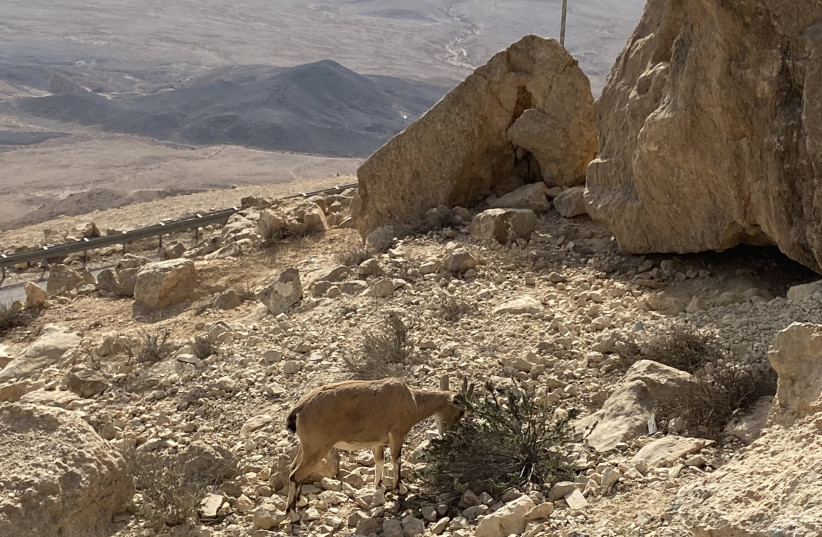On the cliffs of Ein Gedi, mountain goats climb high in a pack, their smooth and tawny coats almost blending into the golden rock of the mountain. A pair of horns and large doe eyes crowns each head atop a muscular form. These are Nubian Ibex, a type of desert mountain goat, or yael in Hebrew.
Ibexes are one of those animals that you really must see to understand. The term “mountain goat,” doesn’t do justice to these majestic desert creatures.
As a child growing up in the deep south of the United States, I remember learning about the biblical heroine, Yael, who shares a name with the ibex.
Yael, the female Jewish icon
She was the very symbol of a wily woman’s power, a Jewish ideal of strength and bravery. Yael defeated the Canaanite general, Sisera, by luring him into her tent, lulling him to sleep with soporific foods and wine, and then driving a stake through his head. With this act, Yael turned the Jews’ defeat of the Canaanites at the battle of Mount Tavor into a decisive victory.
When I learned the tale of Yael as a little girl, I found myself instantly connected to her story. My middle name is Yael, so perhaps my captivation with her character had more to do with self-identity than anything else. But back then, far away from the Land of Israel, I remember being very confused about one thing.

A yael was a mountain goat, hardly an animal that deserved to be a namesake (or so I believed). The only goats that I had ever seen were in the Audubon Zoo; they were small and pushy creatures whose loud bleating and rummaging for food in every baby stroller made them unromantic, at best. Of course, I had also read about the Three Billy Goats Gruff storybook.
These goats seemed slightly less pesky than the ones in the zoo. At least, their fluffy coats meant that they were more visually appealing. With these images of the genus Capra in my mind, I could hardly understand why the mountain goat was a worthy namesake, nor why Yael was one of the most popular names for little girls born in Israel.
Years later, while hiking through the cliffs of Ein Gedi in Israel, a new mental picture began to form. A yael was an ibex, a beautiful and graceful creature, one who braved the toughest conditions in order to survive. The ibex’s golden coat and skin had adapted to reflect the sun’s harsh rays, shimmering in the desert heat.
While hiking in the Negev, I have had many an opportunity to witness these creatures’ nimble leaps over impossible mountain bluffs. Towards sunset, we often encounter them high up in desert acacia trees, nibbling on the tough leaves at the end of the branches. Ibex don’t flee in fear upon human approach, like the gazelle and deer of the Jerusalem Mountains. Instead, they continue eating patiently, posing for pictures while we stand a stone’s throw away. Only when we move closer do they leap away, to another tree or high boulder to continue grazing.
Ibex are mentioned several times in the Tanach. Years after Yael the warrior, who lived in the period of the Judges, King Saul pursued David through Ein Gedi onto the “cliffs of the ibex.” It only takes one visit to Ein Gedi National Park to understand this terminology. Ibex are notorious for their preference of mountain cliffs over open terrain, only leaving the safety of rocky precipices to feed, mate, and migrate. They also happen to prefer the constant water supply available in a desert oasis like Ein Gedi, especially during the dry summer season when no rainwater washes through desert streams.
The ibex is also mentioned in the books of Psalms and Song of Songs; for the ancient Israelites, this light-footed creature was well-known, and a useful image for metaphor and poetry.
Although one often associates the shofar, blown on Rosh Hashana, with a ram’s horn, ibex horns were also used. According to the Mishna, the very shofar that was blown on the New Year in the Holy Temple was the straight horn of an ibex, its mouthpiece coated with gold.
All of these elements of our tradition would have been absolutely mystifying to me back in Louisiana before I had the chance to get up close and personal with the yael, the mountain goat of the middle east. Now, here in Israel, I completely understand why the ibex was chosen to be the symbol of the Israel Nature and Parks Authority, the most iconic symbol of Israeli wildlife, and the perfect representative of a beautiful, strong, and resilient nation.
